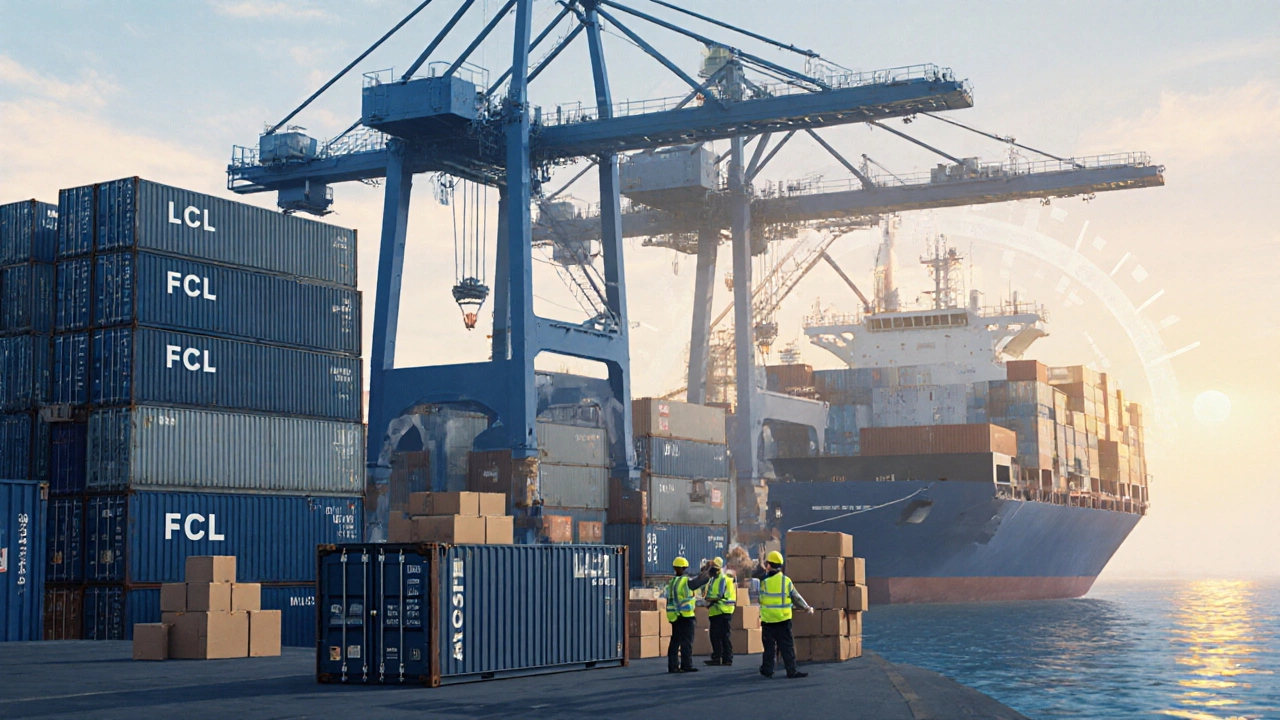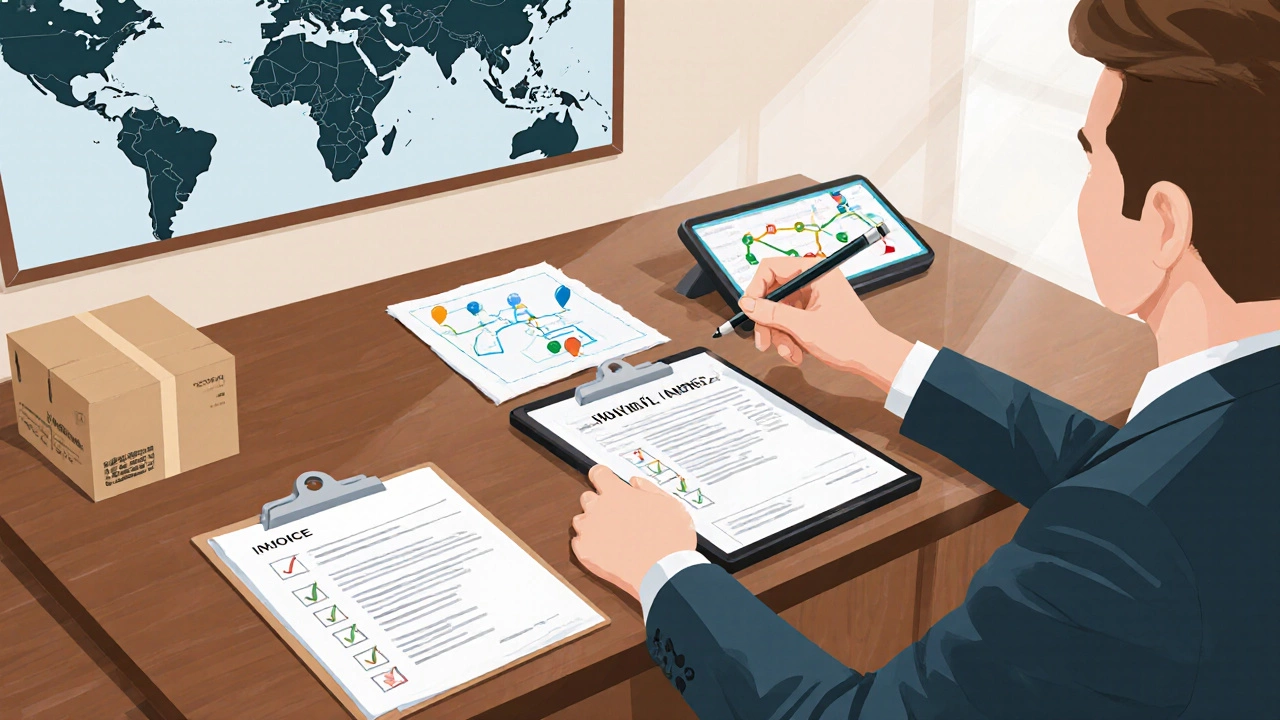International Shipping Cost Calculator
Estimate Your Shipping Costs
Shipping Cost Estimate
Enter details above to see your estimate
Important Notes
These are estimated costs based on 2025 rates. Actual prices may vary depending on:
- Port fees and customs clearance
- Seasonal demand
- Specific destination port
- Insurance and packing requirements
Door-to-door service adds £50-£200 to transit costs. Always check with your chosen carrier for exact pricing.
When it comes to moving a sofa, a fridge, or a whole house full of stuff to another country, the first question on everyone’s mind is cost. You want the cheapest overseas shipping option that still keeps your belongings safe and arrives on time. In this guide I’ll walk through the major methods, break down the hidden fees, and give you a step‑by‑step checklist so you can budget like a pro.
What drives the price of household goods shipping?
Household goods shipping isn’t just a flat rate per kilogram. The final bill is a mix of volume, weight, distance, handling requirements, and the level of service you pick. Here are the key cost drivers you’ll encounter:
- Volume (cubic meters or CBM) - Freight charges usually base on space used, not weight, especially for sea freight.
- Weight - Air freight still charges by kilogram, so heavy items become pricey fast.
- Route & destination port - Shipping to a major hub like Rotterdam or Singapore is cheaper than a smaller, inland port.
- Consolidation - Sharing container space with other customers (LCL) cuts cost but adds handling steps.
- Customs duties and taxes - Vary by country, product type, and declared value.
- Insurance - Optional but recommended; premium usually 0.2‑0.5% of the declared value.
- Pick‑up & delivery - Door‑to‑door service costs more than port‑to‑port.
Understanding these factors helps you spot where you can save - for example, by repacking to reduce volume or choosing a port‑to‑port option if you have a friend who can handle the last mile.
Sea freight: The budget champion
For large moves, sea freight remains the most cost‑effective. You have two main flavors: Full Container Load (FCL) and Less Than Container Load (LCL, also called consolidated shipping). FCL means you rent an entire 20‑ft or 40‑ft container; it’s ideal if you have 15+ CBM of goods. LCL lets you share a container with other shippers, paying only for the space you actually use.
Typical costs (2025 rates) for a 20‑ft container from the UK to the US are around £1,200‑£1,500, while LCL pricing runs about £80‑£120 per CBM. Transit time averages 4‑6 weeks, plus a few days for customs clearance.
Why sea freight is cheap:
- Containers move in massive volumes, spreading costs across many customers.
- Fuel consumption per ton is lower than air cargo.
- Port infrastructure is optimized for bulk handling.
Things to watch out for:
- Port‑to‑port only - you’ll need local transport to get items from the arrival port to your new address.
- Longer transit - not a good fit if you need furniture immediately.
- Potential for damage if items aren’t well‑packed.
Air freight: Speed that comes at a premium
If you’re moving a small apartment or need essential items quickly, air freight can be the answer. Prices range from £4‑£7 per kilogram for standard service, and faster “express” options can climb to £10‑£15 per kilogram. Transit time is usually 3‑7 days, making it attractive for time‑sensitive moves.
Air freight’s main advantage is speed, but the cost escalates fast with weight. A 200‑kg shipment of kitchenware could cost £1,200‑£2,100, which is often more than a sea‑freight LCL for the same volume.
Tips to keep air freight affordable:
- Prioritize high‑value or urgently needed items; send bulk furniture by sea.
- Use a “NVD” (non‑valuable declared) invoice to reduce duties, if permissible.
- Choose a reputable cargo airline that offers consolidated cargo flights, similar to LCL.
Consolidated shipping and LCL: The sweet spot for most families
Most households fall between the extremes of a full container and a tiny air‑freight parcel. Consolidated LCL shipping gives you the best of both worlds: you pay only for the volume you occupy, and you still benefit from sea‑freight rates.Here’s how it works:
- Pack your belongings in sturdy boxes and label each with dimensions (length, width, height).
- Calculate total CBM (multiply dimensions and divide by 1,000,000).
- Request a quote from a freight forwarder - they’ll aggregate your cargo with others heading to the same destination.
- Goods are loaded into a container at the origin port, shipped, then unloaded and re‑consolidated at the destination hub.
- Final delivery is arranged via local trucking or rail.
Average LCL rates for a UK‑to‑Australia move are £90‑£130 per CBM in 2025, with a total door‑to‑door cost (including inland transport) of roughly £1,500‑£2,000 for a 12‑CBM household.

Choosing a freight forwarder - your cost‑saving partner
A good freight forwarder does more than just book space. They can negotiate better rates, pack your goods efficiently, handle customs paperwork, and even consolidate shipments from multiple families to lower the per‑unit price.
When vetting forwarders, ask about:
- Experience with household moves - look for at least 5‑years of residential shipments.
- Transparent pricing - request a detailed quote breaking down ocean freight, terminal handling, documentation, and inland transport.
- Insurance options - many forwarders offer “All‑Risk” coverage for a small premium.
- Customs brokerage - they should handle HS code classification for you.
- Customer reviews - see if previous clients mention hidden fees.
Popular forwarders in the UK market include PSS International, ShipSmart, and the larger players like DHL Global Forwarding. Get at least three quotes and compare the total landed cost, not just the ocean freight price.
DIY vs brokered service - when to go solo
Some adventurous movers choose to handle the shipment themselves by renting a container from a carrier and arranging their own pickup and delivery. This DIY route can shave 10‑15% off the price if you’re comfortable with paperwork and have reliable local transport.
However, the hidden costs can quickly erode savings:
- Mis‑declared weight or volume leads to penalties.
- Incorrect paperwork can cause customs delays and storage fees.
- No insurance coverage leaves you exposed to loss or damage.
For most families, especially first‑time international movers, the brokered service (freight forwarder) offers peace of mind for a modest premium.
Packing, labeling, and insurance - protect your budget
Even the cheapest shipping method can turn expensive if goods get damaged. Follow these bare‑minimum packing rules:
- Use double‑wall cardboard boxes for heavier items.
- Wrap fragile pieces (glass, ceramics) in bubble wrap and place them in the center of a box with padding on all sides.
- Disassemble furniture when possible - fewer large pieces mean less volume.
- Label each box with a clear inventory list, including dimensions and weight.
- Seal boxes with reinforced tape; tape all seams twice.
Insurance is a small cost compared to potential loss. A typical “All‑Risk” policy for a £10,000 household is about £30‑£50. It covers theft, breakage, and mishandling from the moment the goods leave your door to the moment they’re delivered.

Quick cost‑calculator checklist
Before you call any forwarder, run through this checklist:
- Calculate total CBM (use a spreadsheet to sum each box’s volume).
- Decide on service level: Door‑to‑door, Port‑to‑door, or Port‑to‑Port.
- Pick a shipping method - Sea (FCL/LCL) or Air.
- Get at least three quotes that include freight, terminal handling, customs brokerage, and inland transport.
- Ask about insurance coverage and its cost.
- Check any hidden fees: documentation surcharges, storage, demurrage.
- Factor in your own time and effort if you plan a DIY approach.
Plug those numbers into a simple spreadsheet and you’ll see which option lands under your budget.
Comparison of common shipping methods
| Method | Typical cost per CBM (2025) | Transit time | Best for |
|---|---|---|---|
| Full Container Load (FCL) - Sea | £65‑£75 | 4‑6 weeks | Large moves, >15 CBM |
| Less Than Container Load (LCL) - Sea | £90‑£130 | 5‑7 weeks | Medium moves, 5‑15 CBM |
| Consolidated air cargo | £4‑£7 per kg | 3‑7 days | Urgent items, < 500 kg |
| DIY container rental | £70‑£85 per CBM (plus handling) | 4‑6 weeks | Budget‑savvy, experienced shippers |
Final thoughts - how to lock in the cheapest deal
The cheapest way to ship household goods overseas isn’t a one‑size‑fits‑all answer. It’s a mix of method, volume, timing, and partner choice. In most cases, a well‑packed LCL sea shipment with a trusted freight forwarder will give you the best price‑to‑service ratio. Only pull an air freight if you have a handful of high‑value items that can’t wait.
Start early, gather multiple quotes, and use the checklist above to keep hidden fees from sneaking into your final bill. With a clear plan, you’ll move your home abroad without blowing your budget.
What is the difference between LCL and FCL?
LCL (Less Than Container Load) means you share a container with other shippers and pay only for the space you occupy. FCL (Full Container Load) rents an entire container for your goods, which is cheaper per CBM when you have a large volume (usually 15 CBM or more).
Can I ship household goods door‑to‑door with sea freight?
Yes, many freight forwarders offer door‑to‑door service, but it adds a handling fee at both origin and destination. If you’re looking to cut costs, consider port‑to‑port and arrange local transport yourself.
How do I calculate the CBM for my boxes?
Measure length, width, and height in centimeters for each box, multiply the three numbers, then divide by 1,000,000 to convert cubic centimeters to cubic meters. Sum the results for all boxes to get the total CBM.
Is insurance worth the extra cost?
Absolutely. A typical All‑Risk policy costs less than 0.5% of your declared value and protects against loss, breakage, and mishandling. Without it, a single damaged item could wipe out the savings from a cheaper freight rate.
What paperwork do I need for customs?
You’ll need a commercial invoice (or a personal “household goods” invoice), packing list, bill of lading, and any required import permits for specific items (e.g., electronics, alcohol). A freight forwarder can handle most of this for you.


